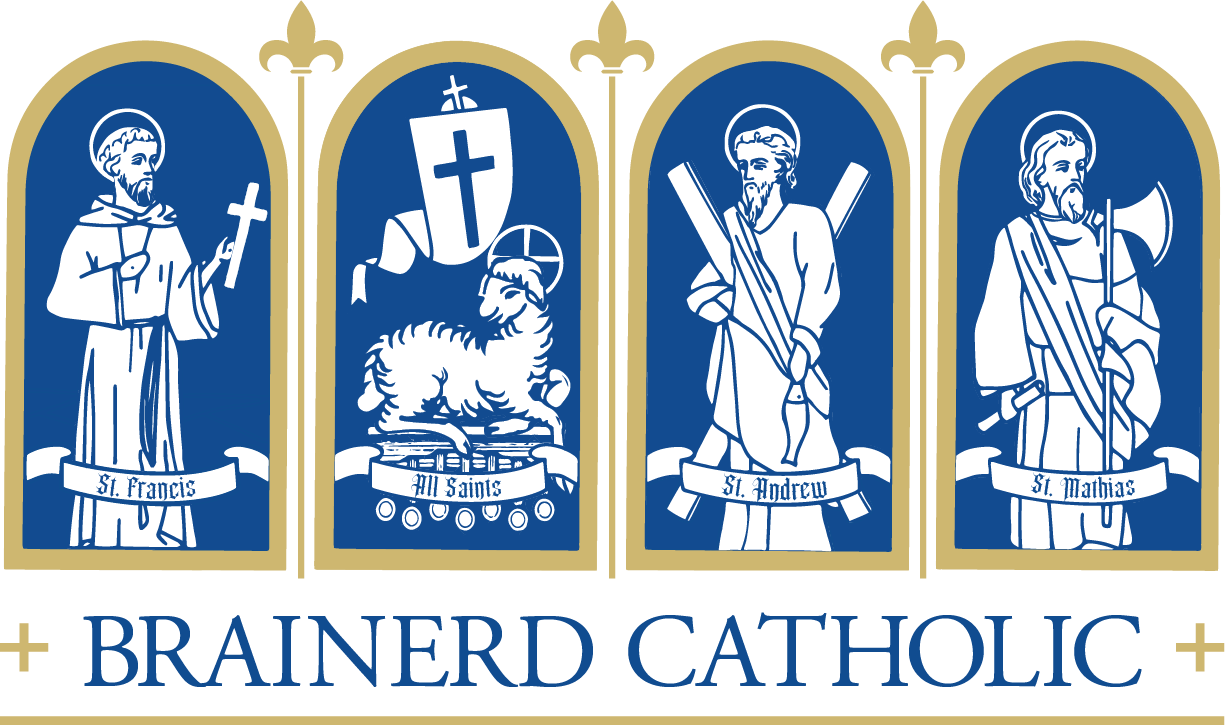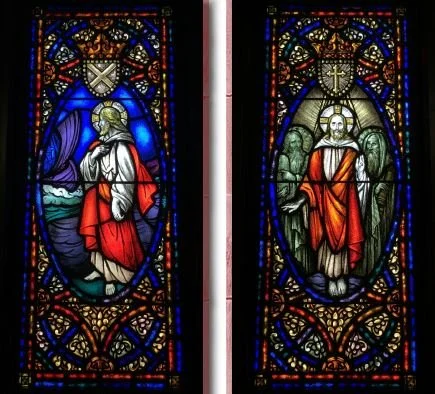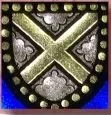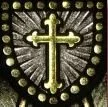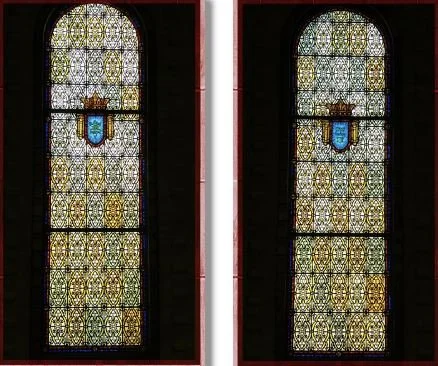Windows of
St. Francis
The beautiful stained glass windows in our Church were designed and manufactured by the artists of the Gaytee Studios, Inc., of Minneapolis, Minnesota. They represent to us the heart of the gospel, the mission of the Church, the zeal and the sanctity of her apostolate and the saints. The beauty of their intricate design and rare coloring is inspirational and unusual, and would be very difficult to reproduce.
The symbols which the artists used to portray historical and traditional characters and events are a part of the language of Christian art, and there is both beauty and mysticism in their meaning.
The people who have given these lasting memorials to the Church have truly enhanced the splendor of God’s house, and have made it a source of edification and spiritual joy to all members of the parish.
The sequence in which the windows are listed in this index corresponds with the bronze plaque which was presented to the Church by St. Francis Guild.
The rose window in the Sanctuary above the altar represents the Crucifixion, and was given by Mr. and Mrs. George Murphy, in memory of Elizabeth Murphy.
The large windows in the transepts are commemorative of the seven sacraments and Purgatory, and it will be noted that each one contains an inset upon which a liturgical symbol is inscribed. The arrangement is as follows.
Gospel Side 1. Baptism and Holy Orders
Symbol – A crown of thorns, which is symbolic of the Passion of our Lord. Given by Mike Reilly.
John 19:2 And the soldiers plaited a crown of thorns, and put it on his head, and clothed him in a purple robe;
Epistle Side 2. Extreme Unction and Purgatory
Symbol – A hammer and pincers. A passion Symbol. Given by Mrs. T. H. Schaefer, in memory of T. H. Schaefer, Sr.
Epistle Side 1. Holy Eucharist and MatrimonySymbol – A seamless coat and three stones. Passion Symbol. Given by George Schaefer.
Gospel Side 2. Confirmation and Penance
Symbol – A lance and a sponge, also a Passion symbol. Given by Mike Reilly.
John 19:34 But one of the soldiers pierced his side with a spear, and at once there came out blood and water.
The gospel side windows were relocated during the construction in 2018-2019 and installed into the doors leading to the new gathering space.
The windows from the original north side Usher’s room (confessional) were relocated to the northwest corner of the building outside the restrooms.
The Ambulatory
The Ambulatory, or lower windows along the aisles, contain the gospel story from Mary’s home in Nazareth to the descent of the Holy Ghost. They are carried out in figure subjects in the life of Our Lord, and each one is likewise inscribed with a liturgical symbol. Beginning at the Gospel side of the Church nearest the altar, and listed in sequence around the Church, they are as follows.
The Annunciation
Symbol – Keys Saltire, representing St. Peter.
Given by Mrs. Elizabeth Arbes, Mrs. Anna Steinbach, Anthony Arbes, and Mrs. Mary Rubbelke
Luke 1:30-31 And the angel said to her, “Do not be afraid, Mary, for you have found favor with God. And behold, you will conceive in your womb and bear a so, and you shall call his name Jesus.
The Marriage of the Blessed Virgin
Symbol – A Pilgrim’s staff, representing St. James, Major. Given by M. J. O’Connor
Matt 1:18 Now the birth of Jesus Christ took place in this way. When his mother Mary had been betrothed to Joseph, before they came together she was found to be with child of the Holy Spirit.
The Visitation
Symbol – A carpenter’s square and a vertical spear, representing St. Thomas. Given by W. J. Cahill
John 19:2 And the soldiers plaited a crown of thorns, and put it on his head, and clothed him in a purple robe;
The Nativity
Symbol – A Patriarchal Cross and Basket, representing St. Philip. Given by Ann Rifenrath
John 19:34 But one of the soldiers pierced his side with a spear, and at once there came out blood and water.
Adoration of the Three Wise Men
Symbol – Three purses, representing St. Matthew. Given by the Junior Holy Name Society; and Holy Angel’s Sodality.
Matt 2:11a and going into the house they saw the child with Mary his mother, and they fell down and worshipped
The Flight into Egypt
Symbol – A knotted club, representing St. Jude. Given by Edw. J. McMahon
Matthew 2:14 And he rose and took the child and his mother by night, and departed to Egypt.
Boy Christ Discoursing in the Temple
Symbol – Cross Saltire, representing St. Andrew. Given by Ben Kocher
Luke 2:49 And he said to them, “How is it that you sought me? Did you not know that I must be in my Father’s House?
The Baptism of Our Lord
Symbol – A Chalice and serpent, representing St. John, the Evangelist. Given by Mrs. Con O’Brien
Mark 1:9 In those days Jesus came from Nazareth of Galilee and was baptized by John in the Jordan.
The Marriage at Cana
Symbol – An arrow, representing
St. Sebastian. Given by the Caulfield family, in memory of Mr. and Mrs. Thomas Caulfield
John 2:1 On the third day, there was a marriage at Cana in Galilee, and the mother of Jesus was there.
Our Lord Stilling the Tempest
Symbol – An open bible and a flaying knife, Representing St. Bartholomew. Given by the Caulfield family, in memory of Mr. and Mrs. Thomas Caulfield
Mark 4:39 And he awoke and rebuked the wind; and said to the sea, “Peace, be still!” And the wind ceased, and there was great calm.
Our Lord the Good Shepherd
Symbol – A book and a fish, representing St. Simon. Given by J. F. Loeb
John 10:11 I am the good shepherd. The good shepherd lays down his life for his sheep.
The Sermon on the Mount
Symbol – A battle ax, representing St. Matthias. Given by E. J. Quinn
Matt 5:1-2 Seeing the crowds, he went up on the mountain, and when he sat down his disciples came to him. And he opened his mouth and taught them.
The Transfiguration
Symbol – A Latin Cross Botonee’, symbolizing Faith, representing St. Denis. Given by Very Rev. Thomas F. Scott
Matthew 17:2 And he was transfigured before them and his face shone like the sun, and his garments became white as light.
Our Lord Walking on the Water
Symbol – A Saltire Cross, representing St. Patrick. Given by L. W. Roscoe family, in memory of Richard Roscoe.
John 6:19 When they had rowed about three or four miles, they saw Jesus walking on the sea and drawing near to the boat. They were frightened.
Our Lord at the House of Mary and Martha
Symbol – A lily, representing St. Joseph. Given by the Daughters of Isabella.
John 11:20 When Martha heard that Jesus was coming, she went and met him, while Mary sat in the house.
Our Lord Blessing the Little Children
Symbol – A bible transfixed with a sword, representing St. Boniface.
Given by George Bisiar
Matthew 19:13 but Jesus said, “Let the children come to me, and do not hinder them; for to such belongs the kingdom of heaven.”
Our Lord’s Entry into Jerusalem
Symbol – A shield and a cross, representing St. George. Given by Dr. And Mrs. Werner Hemstead.
Matt 21:4-5 This took place to fulfil what was spoken by the prophet, saying, “Tell the daugh-ter of Zion, Behold, your king is coming to you, humble and mounted on a donkey, and on a colt, the foal of a donkey.”
Our Lord in the Garden of Gethsamane
Symbol – Crossed Palms, representing St. Stanislaus. Given by L. A. A. O. H.
Mark 14:32 And they went to a place which was called Gethsem’ane; and he said to his disciples, “Sit here while I pray.”
The Resurrection
Symbol – A black eagle, rep-resenting St. Wenceslaus. Given by the Vaars children, in memory of Mr. and Mrs. Peter Vaars
John 11:25 Jesus said to her, “I am the resurrection and the life; he who believes in me, though he die, yet shall he live.”
Our Lord Appears to Mary Magdalene
Symbol – A cross on a dark rayed background, Representing St. Francis Xavier. Given by the Vadnais children, in memory of Mrs. Eva Vadnais
John 20:18 Mary Mag’dalene went and said to the disciples, “I have seen the Lord”; and she told them that he had said these things to her.
The Ascension of Our Lord
Symbol – Three golden balls on a book, representing St. Nicholas of Myra.
Given by Maurice Manning
Mark 16:19 So then the Lord Jesus, after he had spoken to them, was taken up into heaven, and sat down at the right hand of God.
The Supper at Emmaus
Symbol – A scroll and rays of light, representing St. Anne. Given by Mrs. C. D. Quinlen and children, in memory of C. D. Quinlen
Luke 24:30-31 When he was at table with them, he took the bread and blessed and broke it and gave it to them. And their eyes were opened and they recognized him, and he vanished out of their sight.
The Descent of the Holy Ghost
Symbol – A vertical saw, representing St. James Minor. Given by Joe Tuholsky
John 20:22-23 And when he had said this, he breathed on them, and said to them “Receive the Holy Spirit. If you forgive the sins of any, they are forgiven; if you retain the sins of any they are retained.”
Saints represented by ambulatory windows:
St. Peter: Feast day: June 29 Pa-tron of fishermen, net makers, and ship builders
St. James the Greater: Feast day: July 25; Patron of pilgrims and Spain
St. Thomas: Feast day: July 3 Pa-tron of architects
St. Philip: Feast day: May 3
St. Matthew: Feast day: September 21; Patron Bankers
St. Jude: Feast day: October 28; Patron of Desperate causes, desperate situations, lost causes
St. Andrew: Feast day: November 30; Patron of Fishermen, singers, Scotland, Romania, Russia, Ukraine and Patras
St. John the Evangelist: Feast day: December 27; Patron of love, loyalty, friendships, and authors
St. Sebastian: Feast day: January 20; Patron of soldiers, athletes, and those who desire a saintly death
St. Bartholomew: Feast day: August 24
St. Simeon: Feast day: August 24
St. Matthias: Feast day: August 24
St. Patrick: Feast day: March 17; Patron of Ireland
St. Denis: Feast day: October 9; Patron of France; Paris; against frenzy, strife, headaches, hydro-phobia, possessed people, rabies
St. Joseph: Feast day: March 19th & May 1st Patron of the Universal Church, unborn children, fathers, workers, travelers, immigrants, and a happy death
St. Boniface: Feast day: October 9; Patron of France; Paris; against frenzy, strife, headaches, hydro-phobia, possessed people, rabies
St. George: Feast day: April 23; Patron of England & Catalonia
St. Stanislaus: Feast day: April 11
St. Wenceslaus: Feast day: September 28; Patron of Bohemia, Czech state, Prague
St. Francis Xavier: Feast day: December 3; Patron of Catholic missions; African missions; Goa, India; China; missionaries
St. Anne: Feast day: July 26
St. Nicholas of Myra: Feast day: December 6; Patron of Bakers and Pawnbrokers
St. James Minor: Feast day: May 3; Patron of Hatmakers
The celerestory windows
The Clerestory windows, which are the higher windows above the aisles in the nave of the Church, are carried out in a grisaille back-ground, also with symbolism. The softly blend-ed colors and intricate design in these windows make them indeed a work of art. Beginning on the Gospel side of the Church, nearest the altar, and listed in sequence around the Church, they are commemorative as follows:
The lower transept windows represent the four Cardinal Virtues, and are arranged thus:
Gospel Side 1. Prudence
Symbol – A serpent Given by Rev. James A. Hogan
Matt 10:16 “Behold, I send you out as sheep in the midst of wolves, so be wise as serpents and innocent as doves.”
Gospel Side 2. Justice
Symbol – Scales
Given by Mr. and Mrs. C. A. Ryan and Mr. and Mrs. D. I. Ryan
Job 31:6 (Let me be weighed in a just balance, and let God know my integrity!)
Epistle Side 1. Fortitude
Symbol – A sword and sheath
Given by Mr. and Mrs. M. E. Hitch
Ephesians 6:17 And take the helmet of salvation, and the sword of the Sprit, which is the Word of God.
Epistle Side 2. Temperance
Symbol – A shaft of light Given by Mr. and Mrs. Clar-ence Sundquist, in memory of Walter and Carol
Titus 2:1-2 But as for you, teach what befits sound doc-trine. Bid the older men be temperate, serious, sensible, sound in faith, in love and in steadfastness.
A lantern, sword, cross and staff
Symbolic of –St. Jerome Given by Women’s Catholic Order of Foresters
A heart, surrounded by flames, pierced with two arrows
Symbolic of – St. Augustine of Hippo. Given by a friend
A radiant sun with an eye within it
Symbolic of – St. Thomas Aquinas
Given by the students of St. Francis School
A lily
Symbolic of – St. Anthony of Padua
Given by the Lampert Lumber Company
A beehive
Symbolic of –St. Ambrose Given by W. H. Gemmel
A crucifix and a book
Symbolic of – St. Gregory the Great
Given by Rose Bechtold
A rayed crucifix
Symbolic of –St. Bonaventure Given by Mrs. Peter McGivern, in memory of Clarence J. Moore
A crucifix and a lily
Symbolic of – The Little Flower (Teresa of Avila) Given by Lois, Alvena, & Maurice J. Manning
A saw
Symbolic of – the Prophet Isaiah
Given by Mr. and Mrs. M. E. Ryan
A crown and scepter
Symbolic of – the Prophet Ezekiel
Given by Mrs. J. W. O’Brien, in memory of J. W. O’Brien
A shepherd’s crook
Symbolic of – the Prophet Amos
Given by Mr. and Mrs. Walter McComas
A scroll containing his prophecies
Symbolic of – the Prophet Zacharias
Given by Col. And Mrs. E. B. Miller, in memory of James Miller
A Fuller’s bat (a club & three stones)
Symbolic of – the Prophet Jeremiah
Given by Mr. and Mrs. Wm. Hannah and family, in memory of Rt. Rev. Msg. James Grover Tougas D. D.
A lion
Symbolic of – the Prophet Daniel
Given by Mrs. J. W. Koop
A lion head and horn
Symbolic of – the Prophet Joel
Given by Clarence Mraz
A Fuller’s bat
Symbolic of – the Prophet Hosea
Given by William Young
Saints & prophets represented in Clerestory windows Doctors of the Church
St. Jerome: Feast day: September 30; Patron of archaeologists, Biblical scholars, librarians, students and translators
The lantern is a symbol of illumination and intellect which is closely associated with St. Jerome. The sword, cross and staff are other common Christian symbols that reflect other attributes of the saint, such as the cross and staff.
St. Augustine of Hippo: Feast day: August 28; Patron of brewers The heart was considered to be the source of understanding, love, courage, devotion, sorrow, and joy. The pierced heart are used as attributes of St. Augustine, symbolizing God's guidance of his zeal.
St. Thomas Aquinas: Feast day: January 28; Patron of students and all universities. The radiant sun and the eye symbolize St. Thomas’ illuminating light of the truth for all the church, as well as can be seen as a symbol of purity.
St. Anthony of Padua: Feast day: June 13; Patron of Lost Things
St. Anthony is associated with the lily due to purity, but also there is said to be a powerful sacramental association to blessed lilies in his name.
St. Ambrose: Feast day: December 7; Patron of Beekeepers, beggars, learners, Milan. The beehive is symbolic of the story that as an infant his face was swarmed by bees signifying his future eloquence and “honey” tongue.
St. Gregory the Great: Feast day: September 3; Patron of musicians, singers, students, and teachers. St. Gregory is often depicted with a book, because of his extensive knowledge of the scriptures, and the crucifix.
St. Bonaventure: Feast day: July 15;
Bonaventure’s way of thinking was said to be entirely Christocentric, thus a depiction of the symbol of the crucifix makes sense. Also the vision of the 6 winged seraph signifies the stages of illumination, thus the rays of light.
St. Teresa of Avila: Feast day: October 15; Patron of Headache sufferers, Spanish Catholic Writers. Because of her desire to be beautiful as a little flower in the Garden of God, she is depicted by a lily after her nick-name, The little Flower. She suffered greatly in her 24 short years and united her sufferings to Jesus on the cross.
Old Testament Prophets
Isaiah: Hebrews 11:37 They were stoned, they were sawn in two, they were killed with the sword; they went about in skins of sheep and goats, destitute, afflicted, ill-treated. * According to Jewish tradition in the Talmud and Martyrdom of Isaiah, Isaiah was sawn in two by Manasseh and therefore is symbolized by a saw.
Ezekiel: Ezekiel 16:12 And I put a ring on your nose, and earrings in your ears, and a beautiful crown upon your head. 19:7 Its strongest stem be-came a ruler’s scepter; it towered aloft among the thick boughs; it was seen in its height with the mass of its branches.
Zacharias: Zacharias 5:1 Again I lifted my eyes and saw, and behold, a flying scroll!
Amos: Amos 1:1 The words of Amos, who was among the shepherds of Teko’a, which he saw concerning Israel in the days of Uzzi’ah king of Judah and in the days of Jerobo’am the son of Jo’ash, king of Israel, two years be-fore the earthquake. * Amos, as a shepherd, is symbolized by the shepherd’s crook.
Jeremiah: Jeremiah 13:1 Thus said the Lord to me, “Go and buy a linen waistcloth, and put it on your loins, and do not dip it in water.” 11 For as the waistcloth clings to the loins of a man, so I made the whole house of Israel an the whole house of Judah cling to me, says the Lord, that they might be for me a people, a name, a praise, and a glory, but they would not listen. * The fuller’s bat is typically one of the symbols of betraying God.
Daniel: Daniel 6:16 Then the king commanded, and Daniel was brought and cast into the den of lions. The king said to Daniel, “May your God, whom you serve continually, deliver you!”
Joel: Joel 1:6 For a nation has come up against my land, powerful and without number; its teeth are lions’ teeth, and it has the fangs of a lioness. 2:15 Blow the trumpet in Zion; sanctify a fast: call a solemn assembly;
Hosea: Hosea 1:2 When the Lord first spoke through Hose’a, the Lord said to Hosea, “Go, take to yourself a wife of harlotry and have children of harlotry, for the land commits great harlotry by forsaking the Lord.”
* The fuller’s bat is typically one of the symbols of betraying God.
Baptistry
The two windows in the Baptistry contain baptismal symbols. **The Baptistry was converted into a confessional with the 2018-2019 construction project.
The Holy Ghost
signified by a dove.
Given by Margaret Michels
Mark 1:10 And when he came up out of the water, immediately he saw the heav-ens opened and the Spirit descending upon him like a dove;
Baptism, signified by a font, and rays of light
Given by Cecelia Kampmann
Hab 3:4 His brightness was like the light, rays flashed from his hand; and there he veiled his power.
A new confessional in the church was completed spring 2019 which is now where the Baptistry windows were originally located.
Choir Stairs
Holy Sacrifice of the Mass – indicated by the chalice & Sacred Host
Given by Geo. A. Kampmann, Jr.
1 Cor 10:16 The cup of blessing which we bless, is it not a participation in the blood of Christ? The bread which we break, is it not a participation in the body of Christ?
Prayer – shown by a Thurible containing incense, sending its sweet-scented rays to heaven
Given by Mrs. Geo. H. Kampmann, Sr
Rev 8:4 and the smoke of the incense rose with the prayers of the saints from the hand of the angel before God
Liturgical Music –symbolized by a Syrinx, a biblical musical instrument.
Given by Barbara Friedsam
Sirach 40:21 The flute and the harp make pleasant melody, but a pleasant voice it better than both.
Usher’s Room (Reconciliation Room)
Holy Eucharist –
signified by a pelican
It was believed that pelicans, during feeding, appeared to be stabbing itself in the breast and letting its young drink its blood when no food was available. The pelican became symbolic of Christ’s passion, pouring out his blood for the forgiveness of sins, as well as the Eucharist.
Christianity, signified
by Paternoster Cross
The Paternoster Cross is made up of beads or circles, and represents prayer. They were often used as a rosary and would have the Lord’s Prayer said on the center bead, and the Hail Mary’s on the smaller ones. Both given by St. Francis Guild
West view of the newly completed church addition
East view showing the newly completed office and main entrance. Photos taken on August 6, 2019.
The St. Francis statue below was moved from the front of the church and relocated to the back of the church during the construction project.
Copyright © 2019 Angela Gadacz, All Rights Reserved
ISBN: 9781088577516
Cover photo: Angie Gadacz August 7, 2019
This book is a compilation of information drawn from the church archives about the windows. The photo of the rose window behind the altar is credited to Amy Kalthoff. The remainder of the photos were taken either by Angela Gadacz, or Trana Video Productions LLC. Scripture verses and informa-tion about the symbols were compiled by Angela.
